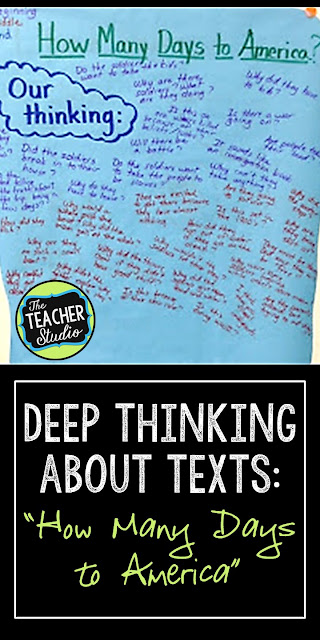Yesterday we kicked off our immigration unit with an A-MAZING visit from a 90 year old woman who had immigrated from Germany back in the mid 20’s. She was a sharp as a tack–and her story was so interesting. I hope I can remember so many things when I am her age! I can barely remember to put two shoes on now and I am half her age!
This unit is one of my favorites . . . there are so many fascinating things to learn and so many great pieces of literature that can be tied to the unit. I always start off–before I even tell them what we are studying–with a close read of Eve Bunting’s “How Many Days to America”. What I find so interesting about this text is that it isn’t an “in your face” immigration story; instead, it is a story about people . . . about decisions that need to be made . . . about family . . . about gratitude–and so much more.
Tracking Our Thinking and Looking for Text Evidence
So, I ask my students to come by the easel with their reading response notebooks and I tell them we are going to be reading closely and tracking our thinking. I explain that I will read a few pages and then will pause and give them time to write their thoughts. They are welcome to write as I read if they have something urgent to record. At each pausing point (I think I stopped 5 times during the text), I ask them to turn and talk to a neighbor or two close to them and then we share out as a class.
As a class, we “track our thinking” as I record on a chart. We practicing piggybacking off others ideas, asking questions, and “reading closely” to notice important elements of the text. I start off writing in one color . . .
Then as we get deeper into the text I switch to another color . . .
. . . and then finish in a third color. Organizing the chart with colors allows us to “notice” things about how our thinking changes as the book progresses. I love to hear the students saying things like, “Well, at the beginning I was wondering about . . . but now I know that . . . ” and so on! Helping them see to refer BACK to the text to proe their thinking is so important. Simply saying, “Is there a war?” isn’t nearly as meaningful as when a student says, “I wonder if there is a war going on because I noticed that…”.
After we finish the text, I ask the students to break up into their small groups and refer both to their notebooks and the chart and talk about what their final reflections and thoughts on the book are. I ask them to consider things such as:
Why did the author write this text?
What are you still wondering?
How did your understanding change as we moved through the story?
I know this isn’t rocket science, but if you are looking for a different way to engage students in a text–especially a text that ties so well to your content, give it a try! It engages all the students, practices their discussion skills, their upper level thinking, and leaves a “trail” of thought that we can refer back to as the unit unfolds. After our discussion, we pulled down the map and drew inferences about the setting . . . about why we thought the author wrote the text . . . about unanswered questions. It was a great “kick off” to our unit–and led us to tonight’s homework.
“If you get home from school tonight and your family tells you to rush and pack a small suitcase–that you are leaving and may not come back–what would you take?”
This really is one of my favorite books to read with students…so much inferring, so many great discussions. I have actually written up some of my thoughts and questions in this little resource if you find it helpful! Just click the image below.
Want to pin this post for later?





